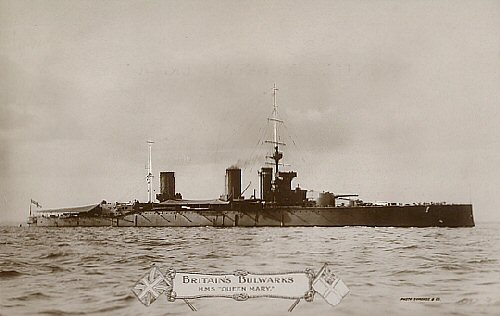
Battle of Jutland - came under fire and sank 31 May 1916
HMS Queen Mary was a Royal Navy battlecruiser, of the Lion class, although she differed in details from her half-sisters. She was armed with eight 13.5 inch (343 mm) guns, displaced 27,000 tons, and was capable of steaming at 28 knots (52 km/h). Externally she differed from her two half-sisters in that she had round funnels (instead of oval), and had her 4 inch guns all on the same deck.
Upon commissioning, she joined the 1st Battlecruiser Squadron. On 28 August 1914, she took part in the 1st Battle of Heligoland Bight. She was under refit at the time of the Dogger Bank battle, so she did not take part in that engagement. After completing her refit, she re-joined the 1st Batttlecruiser Squadron.
She was under the command of Captain Cecil I. Prowse at the Battle of Jutland on 31 May 1916. She had fired about 150 13.5 in shells and scored 4 hits on the SMS Seydlitz, but the Seydlitz hit back. Queen Mary was first hit above the right gun on 'Q' turret; this gun was out of action, but the left gun kept firing. Shortly after, more 30.5 cm (12 inch) shells hit her forward near 'A' and 'B' turrets, and another hit 'Q' turret. The forward magazine exploded, the ship listed to port, and more explosions followed as the ship was sinking. All but twenty of her 1,275 crew were lost (two of the survivors were picked up by German ships).